More of Bhutan
Access to internet has been non-existent for a few days.
Today was a 95km/4 hour ride from Mongar to Trashigang. I was back on the the bike for the first time in several days. A nice return - with a few mountain passes and lots of ice that brought down five bikes. Fortunately I wasn't one of them.
Dylan rode in the van with the cameraman. He was running a slight temperature and not feeling so well, but is a lot better tonight.
I missed riding yesterday's climb over Bhutan's highest mountain pass at 3,800m. Both Dylan and I did it in the bus. We had spent the whole day higher than anywhere in Australia; and most of it above 3,000m.
We have our last full day in Bhutan tomorrow. It's a long ride to the border with India. I'll be on the bike but not sure what Dylan will do.
New Year 2011
Paro (Bhutan), 3 January 2011
New Year’s Eve in Darjeeling: 31 December 2010
Darjeeling is nestled on and around a high, steeply-sided ridge. The town square occupies a large flat area just below the peak of the ridge. From the town square a wide pedestrian mall encircles the peak of the ridge, returning to the square. Within the encirclement, stands higher on the ridge the old English church of St >>>>, whose bell tower clock chimes every quarter hour and can be heard across the town centre.
An early morning walk around the mall revealed views of Mt Kangchenjunga, the world’s third highest peak, sitting high in the Himalaya range across the valleys and neighbouring ridges.
Later in the
morning, after a later start than the group, Dylan and I visited the local zoo,
attracted mainly by the elusive snow leopard, and the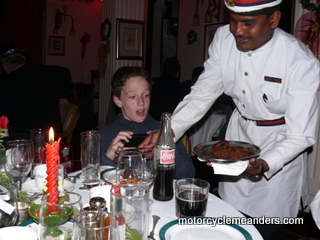 mountaineering institute,
set up by Tensing Norgay, who accompanied Edmund Hilary to the top of Mt
Everest in 1953 – becoming the first to reach the summit. The institute
contains a lot of the gear used in that first ascent to the summit. Norgay was
a native of Darjeeling and his ashes are entombed in the institute grounds.
mountaineering institute,
set up by Tensing Norgay, who accompanied Edmund Hilary to the top of Mt
Everest in 1953 – becoming the first to reach the summit. The institute
contains a lot of the gear used in that first ascent to the summit. Norgay was
a native of Darjeeling and his ashes are entombed in the institute grounds.
In the afternoon we did a ‘toy run’ on the bikes to a refuge for mentally disabled people run by the Sisters of Charity. We all bought and brought gifts of various sorts. Most of the inmates were adult women whose glowing faces and overt pleasure at receiving even the simplest of presents made the trip a very emotional but rewarding experience.
The Elgin Hotel had an elaborate New Year’s Eve party planned. Bon fires and cocktails in the garden at 7.30pm; a ‘cultural event’ in the garden’s pagoda (local singing and dancing troupe); dinner at 9.00pm – with all the tables lavishly decorated; followed by a DJ-led night of dancing. Then, at or soon after midnight, their own fireworks, with Dylan soon into the fray with hotel staff lighting the fireworks.
We gave ourselves a 9.00am start next morning.
Into Bhutan: 1 January 2011
The ride out of Darjeeling was very slow and careful. It had rained overnight, the roads through town are unbelievable steep, mud patches abounded, and there were the toy train tracks to cross at least half a dozen times. The trek down the ridge and across to neighbouring ridges, as we found several back roads to join us with the ‘highway’ towards Bhutan, was mostly steep, tight, wet and slippery. It was a relief to reach the bottom of a valley and stop for a warming chai.
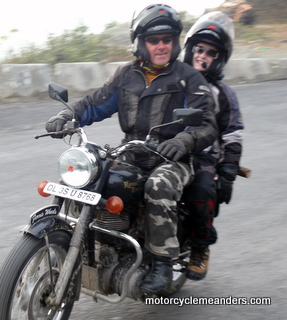 With the ‘highway’
came the inevitable load of trucks and other traffic, but we encounter that on
every trunk road in India. Frustratingly, it was on this more easily manageable
section that making our way up the line of a convoy of army trucks, lead to a
second drop of the bike. It was a harder fall for me, but Dylan bounced
lightly, although not without a telling scrape on his helmet and a few sore
muscles next day. I’ve been confined to the bus since then with some very sore
muscles up my left side towards my back.
With the ‘highway’
came the inevitable load of trucks and other traffic, but we encounter that on
every trunk road in India. Frustratingly, it was on this more easily manageable
section that making our way up the line of a convoy of army trucks, lead to a
second drop of the bike. It was a harder fall for me, but Dylan bounced
lightly, although not without a telling scrape on his helmet and a few sore
muscles next day. I’ve been confined to the bus since then with some very sore
muscles up my left side towards my back.
Dylan was all for getting back on the bike there and then; but that wasn’t an option for his driver!
We arrived late in the afternoon at the border and crossed into Bhutan to the town of Phoensholing for the night.
Although it was dark by the time we arrived, it wasn’t long before Dylan had met some of the local kids around his own age and began several active games. I had to call him in for dinner; and again after dinner to go to bed.
To Paro: 2 January 2011
Today was a steady climb to Paro. Dylan was not too happy at the prospect of spending the day in the bus, so had began the previous evening to sound out Mike [Ferris] to take him on his bike. The upshot was that Dylan rode out with Mike leading the procession out of town and into the mountainous terrain of Bhutan’s interior.
Although the ride in small and comfortable bus was made less comfortable by nursing painful bolts at every bump, I couldn’t help feeling that managing the narrow, climbing road, with any number of landslides that had all but taken the road with them, would have been a stressful challenge. While most of the group are still revelling in the challenge of the roads and conditions, I had already begun to feel the strain of long exhausting days.
But there was no
stopping Dylan. From the time of a late lunch stop, There was filming to do by
Robin from the back of Mike’s bike, so Dylan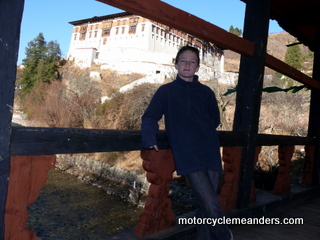 negotiated with Pinky, one of our
mechanics, who was riding tail-end Charlie, to go the rest of the way with him.
negotiated with Pinky, one of our
mechanics, who was riding tail-end Charlie, to go the rest of the way with him.
The drive/ride into Paro saw us come into a very wide, flat valley – no doubt the main reason why Paro has Bhutan’s only airport. It dominates the approach to the town.
Once past the airport, the Paro Dzhong (monastery) looms up. This was a special sight for us as it was the location of a large part of the movie Little Buddha, which Dylan and I had watched together twice as part of preparations for the trip.
Paro: 3 January 2011
Today’s highlights were the climb to the Tiger’s Best monastery (about a 1200m vertical ascent from the bottom to top). I had even brought some of my cycling energy boosters to help ensure I didn’t run out of puff before reaching the top. But a climb to Tiger’s Nest was off the agenda for me.
Darjeeling
Darjeeling, 30 December 2010
Wow! Two days in a row that I’ve been able to write and send something.
As I write this, I’m
sitting in our hotel room in Darjeeling in front of a beautiful fireplace with
a warm coal fire burning. It was all set up, so Dylan enjoyed lighting it. That
was after an afternoon Skypeing and shopping. While I’m quaffing a G and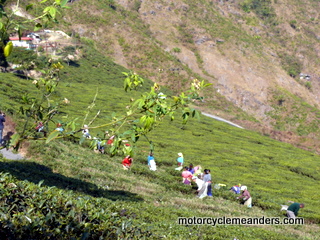 T, Dylan
is having a bath.
T, Dylan
is having a bath.
The Elgin Hotel in Darjeeling is an old British colonial establishment, which still preserves (proudly) all the hallmarks of the era of the British Raj. It’s lavish. Its setting is spectacular. Darjeeling, of course, apart from being famous for its tea, was a renowned ‘hill station’ during the British Raj – a summer retreat to the cool of the high altitudes to escape the suffocating heat and humidity of the lowlands and coastal areas. In fact, it became the summer capital of the Raj.
The ride today from
Siliguri was short by kilometres (120km), but the never-ending climb to the
2000m or so of Darjeeling made for a 5½ ride (nothing as taxing as the day out
of Kathmandu). The ‘main’ road from Siliguri to Darjeeling is shorter by 50km
or so, but landslides forced us to take a back road. The downside was we missed
the criss-crossing of the road by the ‘toy train’ that still 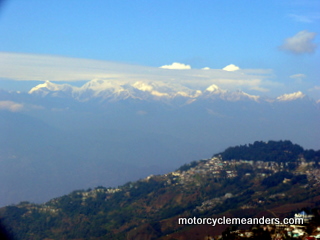 carries ‘real’
passengers between Siliguri and Darjeeling – climbing patiently and painfully
up the hills and ridges to Darjeeling.
carries ‘real’
passengers between Siliguri and Darjeeling – climbing patiently and painfully
up the hills and ridges to Darjeeling.
On the brighter side, the back road was an enjoyable ride on a reasonably good road (mostly) and without the constant challenge of Tata trucks and long wheel-based busses.
The views of Darjeeling from several kms out were enticing. You could see the town nestled on and around a ridge, with the Himalayas as a backdrop. They included the world’s third highest mountain – Kanchenjunga.
Since arriving in Darjeeling, we’ve dropped into the town square, shops galore, and markets. Dylan became engrossed with the Tibetan meditation bowl, which he insisted on buying. I’ve been listening to its ringing tone (a bit like the wine glass ring) ever since.
We have a rest day
tomorrow in Darjeeling, so we’ll see what happens then.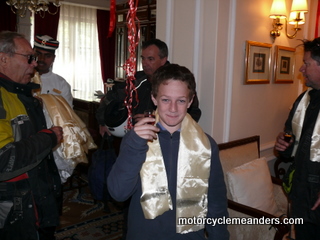
Kathmandu and beyond
Siliguri (India), 29 December 2010
The previous blog was sent on arrival at Pokhara.
Our arrival in Pokhara on 23 December offered only the opportunity to wander down the very tourist-oriented main street to dine on one of the many establishments providing any variety of meal choices.
The next day was the ‘rest’
day in Pokhara. Dylan and I had pre-booked a ‘parahawking’ experience. I’ll not have the time to include
all the relevant links, but you can find them on the main page on the trip.
relevant links, but you can find them on the main page on the trip.
Booking ahead turned out to be a good move. They had actually cancelled all the parahawking for 24 and 25 December but had agreed to accommodate us because we had pleaded for an exception early on. We were the only two who got to do parahawking that day.
An extra bonus was having a vulture each. There are only two vultures trained to land on the arms of the paragliders. So usually one does the morning run with two paragliders; and the other does the afternoon run with two paragliders. The vultures are Kevin and Bob. Partly because of our different weights (leading to very different altitudes) and partly because of the two day planned lay days (=no exercise for the vultures), they brought both Kevin and Bob for us – each carried in the taxis we took from Pokhara to Sarangkot, higher up in the surrounding hills.
It was a great treat, with wonderful views of the Himalayas in the background.
That evening – Christmas Eve – was our Christmas, in keeping with the traditions of many countries that celebrate Christmas on Christmas Eve. We had a fine celebratory dinner in a local restaurant and we even had a Santa Clause.
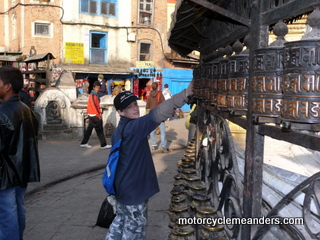 The next day was a pretty straight-forward
run to Kathmandu, the capital of Nepal.
The next day was a pretty straight-forward
run to Kathmandu, the capital of Nepal.
Kathmandu is a sprawling city that fills out most of the Kathmandu Valley. The long slow trek into the vehicle-overloaded centre was the singular most stressing part of the day’s journey.
We then had a full day to explore Kathmandu.
Most of the morning was taken up with a flight along the Himalaya Peaks. The plane kept south, as north was in China. Between everyone having window seats and being brought up to the flight deck, we all saw the amazing sights of the Himalaya Mountains, dominated by Mt Everest.
In the afternoon, a few of us set out to visit the main attractions of Kathmandu itself. These were the temple complexes (World Heritage sites) at Durbar Square in the centre of town and the Swayambhu Stupa high up on a hill overlooking Kathmandu. Both were great experiences. I’ll wait until I write up the story for more detail but the photos on the Dylan album (link in earlier blog) will provide an idea of them.
Next day was a mixed bag.
Six people had Indian visa problems and had to stay back to get them corrected.
That meant that 10 bikes set out to take the old highway south to Hetauda. The old highway went directly over the mountains
– criss-crossing ridge after ridge, climbing to 2400m and descending in the
same manner. It’s no longer used today as the main transit route between India and
Kathmandu; but was for many years. A newer, longer but much quicker road has
been built that goes around the mountains.
to take the old highway south to Hetauda. The old highway went directly over the mountains
– criss-crossing ridge after ridge, climbing to 2400m and descending in the
same manner. It’s no longer used today as the main transit route between India and
Kathmandu; but was for many years. A newer, longer but much quicker road has
been built that goes around the mountains.
The ‘shorter’ way of 130km took us over 7 hours. The climb was relentless. The switchbacks merged into zig-zags, as the road wound its way up and down, across and between the many precipitous ridges. The peak was 2400m. Then the long winding way down the other side.
The height – in winter – was not without several stretches of both visible and black ice. These were spread over the higher points on both ascent and descent. They claimed five of the ten bikes, bringing down one of them twice. Six ‘overs’ out of ten riders. Mercifully, Dylan and I stayed upright as we ever so steadily picked our first gear way through the frost and ice. We had a few slips and slides as the back wheel resisted following the front, but each time finally relented and succumbed to the front wheel’s leadership.
The ride up provided several glimpses of the Himalayas, with the peak exposing a view of the length of the Himalayan range.
We eventually descended into Hetauda as dusk.
We then had a long 260km highway ride along Nepal’s Terai (the low-land plains along the southern border). Dylan made a good choice to ride in the bus. He was dead beat. He slept most of the time and still slept soundly that night at Bratnagar.
This was followed by a shorter but again highway ride to the border with India.
We crossed back into India today and have ended up in the town of Siliguri.
Into Nepal
Pokhara (Nepal), 24 December 2010
Access to Internet has not been possible between Delhi and Pokhara – and it’s very slow here. This might need to be a quick catch-up.
20 December
First day’s ride was a traffic-mingling challenge as we made our way out of Greater Delhi heading for Nainital. Our route took us though the Brijghat, a pilgrimage town on the banks of the Ganges (Ganga). It’s here that the charity (called Ganga Brijghat), set-up and run by the mother of Amar, our local tour organiser and manager, is situated. We stopped for as visit and so were able to personally deliver the 40kgs of clothes we had brought – thanks to Dylan’s family and my cycle group, who donated them; and to Virgin Blue and Singapore Airlines, which carried them gratis.
We crossed the holy Ganges and continued our journey to the hill station of Nainital. Somehow, calculations of time to cover the distance had gone awry. This lead to covering the last 30kms in the dark. That might not sound too much of a problem, except that these 30kms were the climb to the hill station – a narrow, constantly winding, twisting road with several longish stretches of rough, rocky gravel road and high beam headlights of trucks coming at you. It took a couple of hours to make the climb and gladly welcome Nainital.
21 December
The compensation for the nightmare of the evening before was to retrace our path back down to the lower plains – in daylight. Even short distances on maps can take a disproportionately long time to cover on pot-holed roads, any number of road work diversions and in teeming traffic which jams to standstills in every town you pass through. Despite that we got to the India/Nepal border at a reasonable time. The processes were slow on both sides and added a delay of more than two hours to the timing for the day’s ride.
Traffic in Nepal was less confronting but there were enough trucks to hinder progress especially as darkness soon engulfed us along the Mahendra Hwy that crosses the whole of Nepal east and west.
It was after 8.00pm before we finally regrouped at the turn-off to Bardia National Park. That was something of a relief as it’s impossible for all the bikes to stay together; and travelling long dark roads with no one anywhere to be seen can be very daunting. At least, I find it so. There is a system of corner marking and a tail end Charlie, but it’s not infallible and I find I’m constantly wondering if something has gone wrong.
The relief, however, was short-lived. We has a 13km ride on little more than a fire trail road, with a river to cross – in pitch black dark of night. While the river was not flowing, there were two long billabongs side, with a mound of gravel between them. You really had to take it on faith that the bottom was sound and the depth manageable. Coming up the gravel mound was a good feeling even though it was quickly followed by dropping back into the next stream, which mercifully was not as deep.
22 December
An early start this morning for elephant rides into the jungle and plains of the national park. The elephants lumbered their way down a river bank and across the river, with a 2 year old calf having to swim alongside to manage the depth. We didn’t see any of the famed Bengal tigers but we caught a glimpse of a native antelope scurrying through the thick bush.
The river crossing on the way out was more fun in daylight. Incongruously, I made a better job of it in the dark if a reasonable benchmark of success is how far up your trouser leg got wet. Last night it was less than half way up my carves. This morning it was half way up my thigh. At least we emerged with bike upright and moving – well until it stalled with the back wheel about 10cms from the water.
Lumbini, the birth place of the Buddha, was our destination. Again it was slower going than had been calculated for this first time tour. By 9.00pm after hours of high beams in my eyes and still another hour of riding, Dylan and I had had enough and retreated to the support bus, imposing on one of the mechanics to ride the final stretch.
Sadly, being so late and with another long day to follow we didn’t get to spend any time at the Buddist monastery or monument commemorating Buddha’s birthplace. A thick fog prevented even a glimpse of it.
23 December
After making our way back to the bustling town of Butwal that we had come through the previous night which would give us our first view of the Himalayas. Although we had only 200kms to cover for the day, it still took all day, but thankfully we got to Pokhara before the sun set, but only just!
One of the innumerable corners as we encountered as to climbed hills, descended into valleys and climbed even higher out of them was a sharp left-hander that had water running across it. This was nothing unusual but it did contribute to taking the wheels out from under us and having the bike scraped along its side for five of so metres, with rider and pillion seemingly racing alongside of it. No damage done but Dylan was very subdued to the point of refusing to talk. His only sentence was “I told you, Granddad, that the tyres didn’t have good traction!” I subsequently heard about that a few times. We hopped on the support bus for the next half hour until the group had stopped for lunch. Then it was back on the bike for both of us for the next few hours to Pokhara.
We weren’t disappointed by the first views of the Himalayas as we got closer to Pokhara.
24 December
I think the best thing that initially came to mind in arriving in Pokhara was a daylight (more duskish) after three n ight time arrivals. This was closely followed by the thought of a rest day – a 2 night stopover.
But the highlight of this resort town was to be the parahawking. This essentially is paragliding with an accompanying vulture (Egyptian Vultures, which, despite the name, are local).
I haven’t had time to put pictures in the blog or even get a slide show going..except that I have started one on Dylan. This is primarily for his Mum and Dad to follow his adventure but you might like to take a look. This is the link:
http://picasaweb.google.com/MCmeanderer/Dylan?authkey=Gv1sRgCOPcy_Kry47wRg&feat=directlink
First Days in Delhi
New Delhi, 19 December 2010
We’ve just completed three very full-on days in Delhi and Agra, followed by a fourth more leisurely day in Ghaziabad – 20km east of Delhi.
DELHI: Day 1
On the day after our arrival we set out to walk to local markets but soon decided the Red Fort was a better idea. That justified flagging down a motorised rickshaw or tuk-tuk. Dylan had been hanging out to ride one since seeing them on a Hamish and Andy show about India. You feel awfully close to the confusion of traffic in a tuk-tuk weaving its way around and between cars, buses and trucks.
The Red Fort, a product of the Mughal Emperor Shah Jahan, provided Dylan’s first encounter with the many Mughal treasures of India; and he was far from disappointed. He marvelled at the grandeur and was eager to cover it all. We mingled with a couple of school excursions and Dylan soon found himself the centre of attention as they grouped around him to ask him his name and where he came from – a phenomenon that would be repeated several times over the ensuing days.
The near-by Jama Masjid, India’s largest mosque and another product of Shah Jahan, was reached by rickshaw – the pedal sort. You sure get to appreciate the leg work that the poor driver has to exert on the up-hill sections.
The mosque has a huge courtyard and dominating minarets, one of which you can ascend to the very top; and we did.
Both these Mughal-era sites are in the heart of Old Delhi. The main focal point of Old Delhi is Chandi Chowk – a long crowded street of shops, stalls, vendors and people. We pretty much covered the full length on foot. Fortunately, I’m sure Dylan thought, there was a Macca’s half way along. The Macca’s are strictly pork and beef free. Dylan had his usual chicken nuggets and I had a Veggie Mac, the only sort available.
By mid-afternoon, we were heading back to the area of Karol Bagh, where our hotel was situated. This time we tried the Metro. It was easy enough to navigate but not always obvious where the wanted platform was. The first line, from which we had to change lines at the centre of New Delhi, was crowded like I’ve never struck in any Metro anywhere. Getting on and off were both physically and mentally challenging. The second line was a breeze.
Our remaining task for the day was to get into our securely padlocked luggage without the keys, which were presumably on the kitchen bench at home with my mobile phone. After wandering the local Karol Bagh markets without finding a solution, we eventually resorted to prevailing on the hotel to be a bit more imaginative than they had been late the previous night. One of the wallahs went out and bought a fearsome saw blade of some sort or other. He spent a long time, going through two blades and scraping fingers, cutting through the padlocks. But, at least, by the end of the day we had access to our luggage.
DELHI: Day 2
The next day had us back on the Metro to the amazing complex of Swaminarayan Akshardham. That’s a mouthful, but the central concepts, deities and gurus of Hinduism, including its various sects, have names unfamiliar to the non-Hindu world. This complex has absolutely mind-boggling architecture, sculptures, and religious motifs in the traditional Hindu intricacy. Unfortunately, photography was strictly forbidden. That was disappointing but the visit was none the less absorbing.
The Metro was the only practicable option to get from there to Connaught Place – the central retail area of New Delhi. That was a convenient lunch stop before a tuk-tuk got us to the National Museum for a relatively quick visit. We could walk from there to the India Gate, a monumental war memorial to India’s many involvements in conflict, most as part of the British Empire.
Back into a tuk-tuk for a visit to Humayun’s Tomb – another of India’s many World Heritage Sites (we visited five or six such declared sites over three days!). That was probably the highlight of the day. It’s a large complex with several tombs and other monuments. I expect I’ll say more about it (and other places visited) when I write up the story after the trip is over, but for now I’ll need to be brief in saying that the whole site was absorbing; and the actual tomb of Humayum was truly grand. All of it had Dylan quite taken by its size and significance, even though he was also fascinated by the squirrels.
It was well after 6.00pm by the time we got back to the hotel, making it a very long day – but nothing compared to what we had awaiting us on the morrow.
AGRA
Day 3 was a 5.15am pick-up from the hotel to catch a 6.15am Shantabdi Express to Agra. In company with Russell, another of the Ferris group who had also arrived ahead of the tour, we had a car and guide the whole day to take us to the Taj Mahal, the Agra Fort (also called the Red Fort), and Fatephur Sikri. I had initially worried about the expected thee or sop hours we might have to kill before catching the return train at 8.30pm; but that was an ill-conceived worry. We got back to the station at about 8.00pm, having arrived at 8.30am that morning!
The Taj Mahal was no less wondrous seeing it for the second time. The creation of Shah Jahan as a burial tribute to his wife, it has a typically Mughal symmetry in around its precinct expert for the tomb of Shah Jahan himself next to his wife’s; but that added by his son.
The sight and experience of the Taj are unique. It must have a magnetism and fascination that is the equal of no other world monument or natural feature. Its special interior feature is its beautifully executed marble with intricate and delicate designs of in-laid semi-precious stones.
The Agra Fort, built of red sand stone and hence the name of Red Fort, was a creation of Akbar, the most famous and influential of the Mughal emperors. It was the centre piece of his capital at Agra. It was both a military bastion and royal palace; a sprawling city in its own right, surrounded by a moat and several levels of defensive fortifications.
Its size and grandeur were innumerable levels above the Red Fort of Delhi, but, in fairness, the Agra Fort had many different functions.
Fatephur Sikri was another creation of Akbar. It was to be his new capital, located and dedicated in honour of a guru who was attributed to bringing him the blessing of a son and heir. The city took 15 years to build and another14 years to recognise that it didn’t have a reliable source of water. It was abandoned and left to decay. Much of the 11km U-shaped wall still stands, the large lake that bordered the top of the U has long gone, as have most of its buildings; leaving only the royal palace complex and adjacent mosque and tomb of the guru standing. It’s all pretty amazing.
BACK IN DELHI
Such a long day had to be followed by a rest day. The bulk of the group arrived on the evening we got back from Agra, so we went straight from the station to our tour hotel in Ghaziabad, about 20 kms east of Delhi. We hung around next morning while the group went sight-seeing.
However, the afternoon was meet the Royal Enfields time. And that’s what we did. Lessons on the vagaries of this historical bike; test runs around the car park; traditional Hindu blessing invoking the protection of Lord Ganesha, the elephant-headed deity (performed by Lali Singh, a Sikh, owner of the bikes); and general meeting of one another in the group and our mechanics.
I think we’re ready for the ride.
Getting to Delhi
Delhi, 15 December 2010
It’s been a long day. We were in a taxi by 5.00am to catch the Virgin Blue flight to Sydney. A couple of hours in Sydney before boarding the B777 (substituted for the A380 which we were supposed to go on). A stop-over in Singapore to change planes and then into Delhi at about 8.30pm (1.00am next morning Canberra time).
There some extra logistics involved. We had four pieces of check-in luggage weighing a total of just short of 80kgs. And we had to collect our 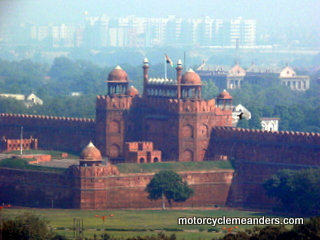 luggage in Sydney and man-handle it to the international terminal on the bus. This came about because I decided to ask the airlines for some complimentary excess baggage to take clothes to the Ganga Brijghat charity that the tour provides some support to. The practice is generally for participants to add a few kgs extra to their luggage. However, both airlines responded positively to my request for an extra 20-23kgs for us together. The quick and generous response from Dylan’s family and my cycle group delivered us 40kgs of clothing. Virgin Blue immediately met the challenge and authorised 40kkgs excess. Singapore had an issue with an already over-book flight because of the change of aircraft and didn’t want to authorise the extra excess up front, but when we turned up in Sydney with the 40kgs they agreed to carry it – and upgraded us to business class, although I don’t think the two decisions were necessarily linked.
luggage in Sydney and man-handle it to the international terminal on the bus. This came about because I decided to ask the airlines for some complimentary excess baggage to take clothes to the Ganga Brijghat charity that the tour provides some support to. The practice is generally for participants to add a few kgs extra to their luggage. However, both airlines responded positively to my request for an extra 20-23kgs for us together. The quick and generous response from Dylan’s family and my cycle group delivered us 40kgs of clothing. Virgin Blue immediately met the challenge and authorised 40kkgs excess. Singapore had an issue with an already over-book flight because of the change of aircraft and didn’t want to authorise the extra excess up front, but when we turned up in Sydney with the 40kgs they agreed to carry it – and upgraded us to business class, although I don’t think the two decisions were necessarily linked.
Anyway, here we are in Delhi with, it almost seems, a room full of luggage.
The Ganges (Ganga) River
Canberra, 11 December 2010
Now, here’s something that I overlooked.
First day out of Delhi has us crossing the Ganges. I’ve never seen the Ganges. But it’s something very special in Indian history and culture; and in Hindu religious traditions and beliefs. To have the opportunity to see it and, hopefully, linger a while to contemplate it will be a highlight of the first day on the bike.
The Ganges rises in the Himalaya Mountains and flows 2,500kms to the great delta in Bangladesh. It has the largest volume of water of any river in India.
Hindus regard the Ganges as the holiest of rivers. It was named after the goddess Ganga, the daughter of the mountain god Himalaya.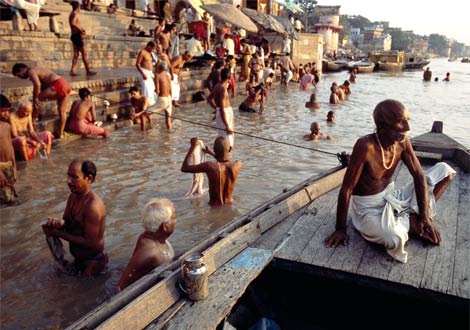
Bathing in the river is believed to wash away one's sins. To bathe in the Ganga is a lifelong ambition for Hindus.
Water from the Ganges is used to cleanse any place or object for ritual purposes. It is believed that any water that mixes with even the smallest amount of Ganges water becomes holy with healing powers.
Hindus also cast the ashes of their dead in the river in the belief that this will guide the souls of the deceased straight to paradise.
It is also important as a national river. Many former imperial capitals were located on its banks.
Jawaharlal Nehru, First Prime Minister of India, wrote of the Ganges:
The Ganges, above all is the river of India, which has held India's heart captive and drawn uncounted millions to her banks since the dawn of history. The story of the Ganges, from her source to the sea, from old times to new, is the story of India's civilization and culture, of the rise and fall of empires, of great and proud cities, of adventures of man…
We cross the Ganges at Brijghat on our way from Delhi to Nainital.
As well as being famous for its many temples, Brijghat is the home of Ganga Brijghat, the charity run by the mother and family of our Indian tour company manager, Amar Sharma; and supported by Ferris Wheels.
(A ghat is a staircase access to the Ganges)
Expectations and Anticipations
Canberra, 10 December 2010
Just as well the trip is not starting today (or some other days this week, for that matter). There are so many flooded roads around Canberra (Wagga Wagga and Rylston – relevant to other participants – also qualify) that you’d be hard pressed to make it as far as the airport.
Forecasts are better for next week.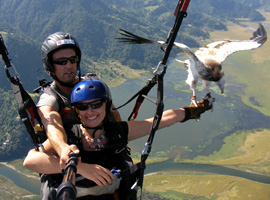
One of the highlights for Dylan will be the Parahawking in Pokhara. He’s quite excited about that. I am a bit too!
We got to hear about this unique activity through an item on the ABC on-line News website, headed Paragliding vultures take to the sky. There’s also a reference to the item on the India, Nepal and Bhutan page. We both plan to do the Parahawking Adventure. Check out this short clip. I don’t expect to have our gloves stolen, but, just in case, we won’t be wearing our motorbike gloves! (Photo at right from parahawking.com)
Another source of expectation and anticipation, especially for Dylan, has been Little Buddha. It’s a Bernado Bertolluci movie of 1993 vintage with Keanu Reeves, Bridget Fonda and Chris Isaak. You  might well query, “Chris Isaak? Wikipedia describes him as “an American rock musician and occasional actor.” Yes. I’d have to say that none of the acting neared Oscar consideration, but the story was cute, a lot of the cinematography was around places we will visit (and which are identifiable in pictures in our guide notes) and underlying the movie story is a sort of sub-story about the birth and life of the young Prince Siddhartha, who becomes the Buddha. All
might well query, “Chris Isaak? Wikipedia describes him as “an American rock musician and occasional actor.” Yes. I’d have to say that none of the acting neared Oscar consideration, but the story was cute, a lot of the cinematography was around places we will visit (and which are identifiable in pictures in our guide notes) and underlying the movie story is a sort of sub-story about the birth and life of the young Prince Siddhartha, who becomes the Buddha. All  in all, the movie helped arouse interest in many aspects of the trip: places and themes either relevant to the story or, indeed, featured in it: Paro in Bhutan, Lumbini and Kathmandu in Nepal; as well as Tibetan religious and political issues; and also, by extension, much of what we’ll discover in Bhutan in terms of Buddhist history and influence.
in all, the movie helped arouse interest in many aspects of the trip: places and themes either relevant to the story or, indeed, featured in it: Paro in Bhutan, Lumbini and Kathmandu in Nepal; as well as Tibetan religious and political issues; and also, by extension, much of what we’ll discover in Bhutan in terms of Buddhist history and influence.
Getting Prepared
Canberra, 6 December 2010
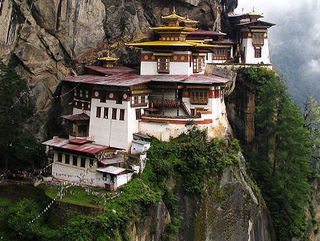 Having decided that I would take a break from overseas motorcycling to devote more time and resources to exploring the Australian Outback (after my Big Trip North and Mt Isa and the Gulf), I was introduced during the Dalmatia trip early this year to a new, re-jigged itinerary that combined Nepal and Bhutan into one trip, with a few days transitting India. My reaction was that this would be the perfect trip to share with my 13 year old grandson, Dylan, who loves riding on the back of the bike with his granddad and has travelled with me on a few trips in Oz (see Riding with my Grandson).
Having decided that I would take a break from overseas motorcycling to devote more time and resources to exploring the Australian Outback (after my Big Trip North and Mt Isa and the Gulf), I was introduced during the Dalmatia trip early this year to a new, re-jigged itinerary that combined Nepal and Bhutan into one trip, with a few days transitting India. My reaction was that this would be the perfect trip to share with my 13 year old grandson, Dylan, who loves riding on the back of the bike with his granddad and has travelled with me on a few trips in Oz (see Riding with my Grandson).
That was seven months ago. It’s now just over one week before Dylan and I set out on this venture. We’ll spend most of the day on 15 December with Singapore Airlines from Sydney to Delhi via Singapore. The fact that the airline has just ditched its scheduled Airbus A380 and replaced it with a Boeing 777 is hopefully a propitious portent for a safe and successful trip.
At Dylan’s initiative, we’ll use a couple of days in Delhi ahead of the motorcycle part of the trip to explore Delhi and visit the Taj Mahal in Agra. We’ll then meet up with the rest of the group and ride the notorious Royal Enfield out of Delhi north to the foothills of the Himalaya Range. Nine days riding through Nepal will be followed by a few days in India tracking the Darjeeling Express before entering Bhutan for another 8-9 days. Then it will be back into India and flying home. By then it will be mid-January 2011.
For Dylan, preparations have included four sets of inoculations against this and that, obtaining a passport, getting visas for India, Nepal and  Bhutan, being introduced to curries, and getting to understand what’s ahead of him in terms of places, people, monuments, history, geography etc. It’s been exciting for him. He’s tackled it all enthusiastically and mastered more than many a tourist might.
Bhutan, being introduced to curries, and getting to understand what’s ahead of him in terms of places, people, monuments, history, geography etc. It’s been exciting for him. He’s tackled it all enthusiastically and mastered more than many a tourist might.
You can read more about our plans, expectations and preparations on my main page on India, Nepal and Bhutan. There’s also a map there that shows our planned route and stopovers. It’s instructive to zoom in and flick between the map, terrain, satellite and earth modes. It’s particularly interesting to zoom in on the Himalaya peaks in Earth mode.
____________________________________________
You’ll be able to follow the trip through this blog. However, it would seem we won’t always have access to the Internet, especially in Bhutan. So at times, there will be gaps of several days between postings.